Equipment
Quick Resolution Tests on Two New 70-200s
We got stock on two new 70-200mm lenses this week: the Nikon 70-200 f/4 VR and the Tamron 70-200 f/2.8 VC. I would have loved to do some side-by-side comparisons. They’re priced similarly and I expect a lot of Nikon shooters will be choosing between these two since both are quite a bit less expensive than the Nikon 70-200 f/2.8 VR II.
It may be a little different on the Canon side, where the Tamron is priced about mid-way between the Canon 70-200 f/4 IS and 70-200 f/2.8 IS II. But there will still be people considering paying a bit more and getting a wider aperture, or paying a bit less for the non-Canon 2.8 version.
As always, this isn’t a review, it’s my quick first impression after putting the lens through our normal intake tests. I’m not a lens reviewer. Also, as always, my summary comes first, for those of you who have trouble reading more than 150 words without a picture.
The Nikon is a very sharp lens, a bit better at the wide end than the long end, but at f/4 it’s every bit as sharp as the 70-200 f/2.8 VR II is at f/2.8. The VR II, of course, does get a bit sharper at f/4.
The Tamron 70-200 (really it’s 186mm) f/2.8 is also exceptionally sharp, and maintains its sharpness throughout the zoom range, even at the long end. Just be aware the long end is not 200mm. We have the Canon and Nikon lenses all measured right at 200mm, while the Tamron is about 186mm. For what it is worth, the Sigma 70-200 f/2.8 is about 190mm.
Here’s a comparison, a simple chart 30 feet away shot with the Canon 70-200 f/2.8 IS II at 200mm on top and the Tamron 70-200 at the bottom. Both were shot from exactly the same place at 200mm. The Nikon 70-200 VR II and f/4 VR are almost exactly the same focal length as the Canon at this distance. (The VRII, of course, is shorter when focused on closer objects.)
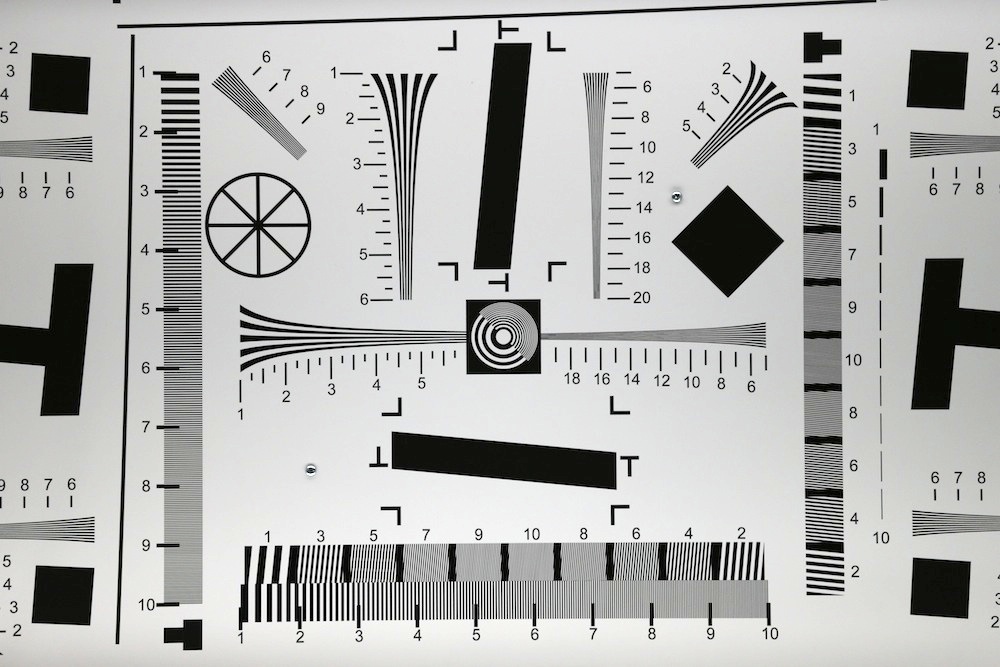
- Canon 70-200 IS II at 200mm
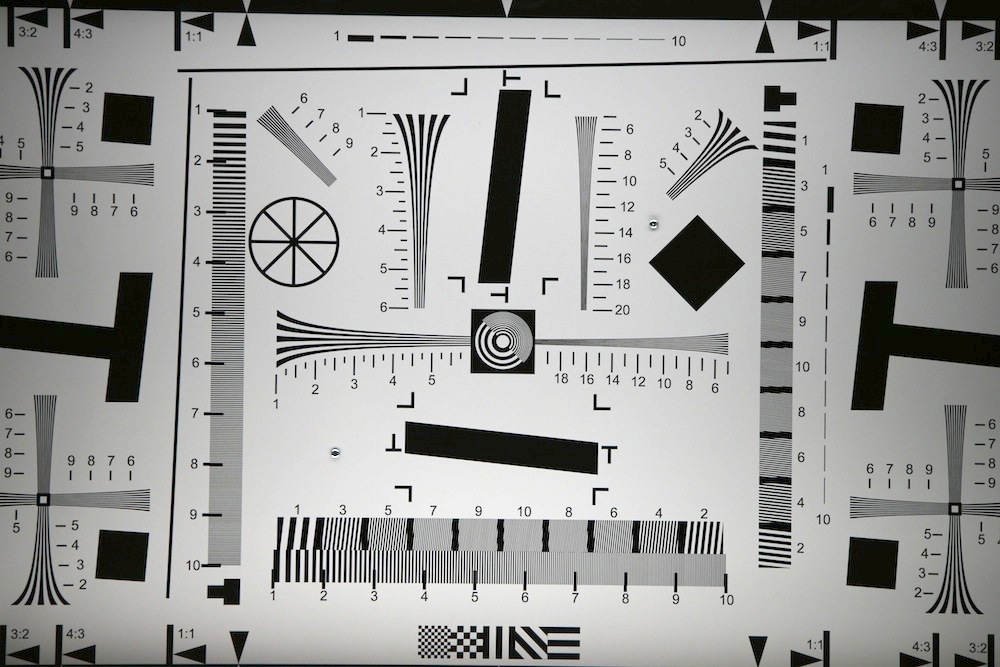
- Tamron 70-200 f/2.8 at 200mm
Or another comparison between the Canon and Tamron.
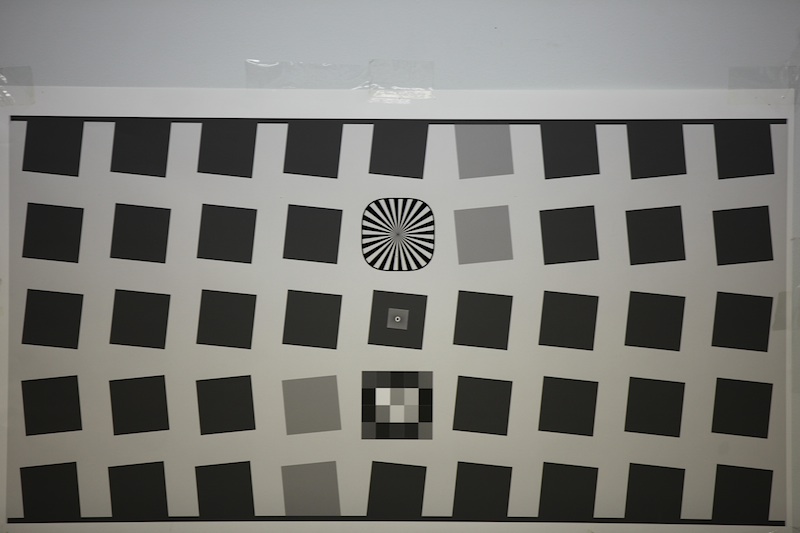
- Canon 70-200 f/2.8 IS II at 200mm
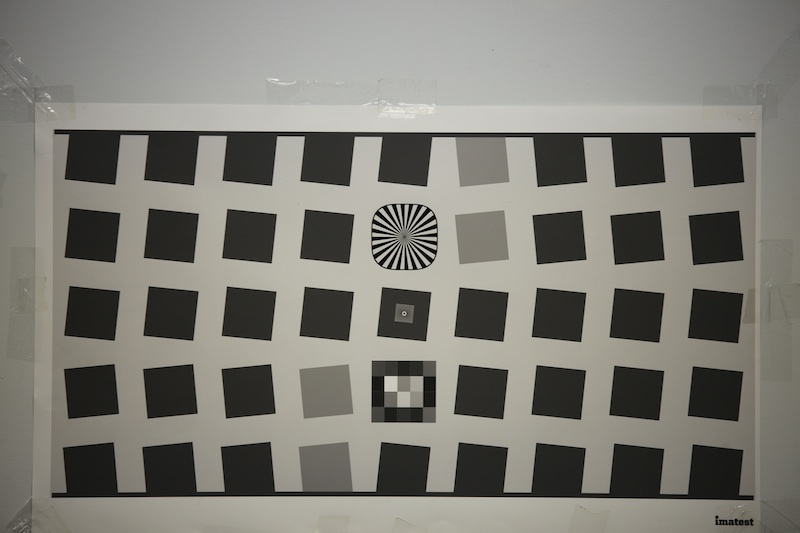
- Tamron 70-200 f/2.8 VC shot from same spot at 200mm
The focal length difference won’t mean doodly to someone using this lens for portraits or landscapes, but to a sportshooter it might be critical.
Other than the focal length surprise, the lenses are both solidly constructed, zoom and focus smoothly, and ooze quality. The Tamron autofocuses very quickly and accurately. It was very close to the Canon and Nikon speeds, and definitely NOT the leisurely AF we suffered from on older Tamron telezooms.
Imatest Results
We don’t have nearly as many copies as I’d like to test, with 9 of the Nikon and 8 of the Tamron available today. But it’s better than one copy, so off we go.
Nikon 70-200 f/4 VR
The Nikon does very well on our standard D3x test camera. For those who want to know why I’m not shooting it on the D800, that’s because I have tons of comparison data on the D3x, and I want to compare this lens to those others. You can’t compare Imatest results from two different cameras. Because, well, then you’re testing the difference in the cameras.
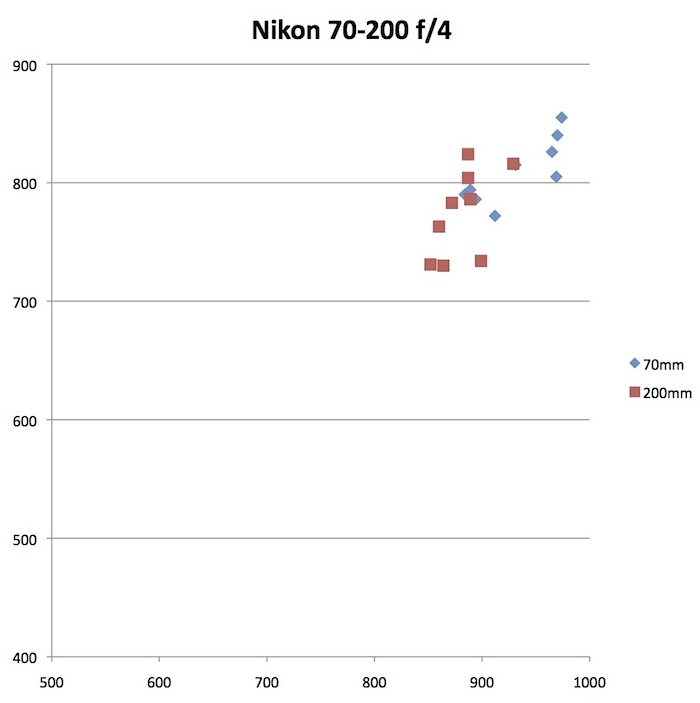
- Line pairs for Image Height for Center (X axis) and Average (Y axis)
Resolution is a bit higher at 70mm than at 200mm, but the difference is pretty minor. It holds sharpness well into the corners with average corner resolution of over 400 LP/IH, which is very good. I’ve compared it in table form below with the Nikon 70-200 f/2.8 VR II, but remember values are wide open, so the f/2.8 is spotting the f/4 a full stop. At f/4, the f/2.8 VR II is clearly a bit sharper than the f/4 VR.It’s probably worth noting the f/2.8 VR II is as sharp at 200mm as it is at 70mm.
| MTF50 CTR 70mm | MTF50 Avg 70mm | MTF50 CTR 200mm | MTF50 Avg 200mm | |
|---|---|---|---|---|
| 70-200 f/2.8 VRII @ f/2.8 | 875 | 730 | 895 | 745 |
| 70-200 f/4 VR @ f/4 | 930 | 810 | 880 | 775 |
Tamron 70-200 f/2.8 VC
The Tamron is also very sharp, and equally sharp at both ends. At 200mm, it actually appears a bit better, but with only 8 copies I’m not willing to make that call yet. I should also repeat, as I always do, that you can’t truly compare Imatest results from one camera system to another so it’s not appropriate to compare the Tamron to the Nikons until we get Nikon mount copies of this lens and test them on the same camera.
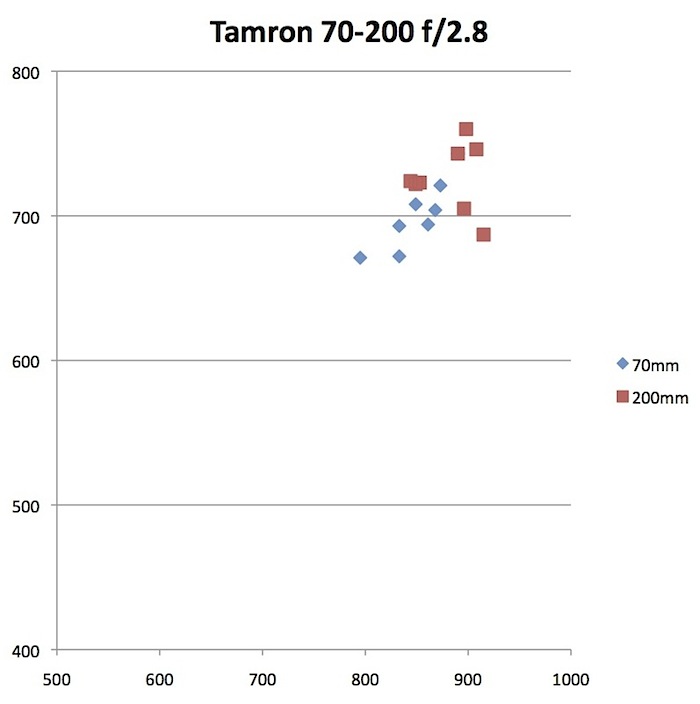
To show just how good these numbers are, we’ll compare them in a table to the Canon 70-200 f/28 IS II, one of the best zoom lenses available.
MTF50 Ctr @ 70mm MTF50 Avg @ 70mm MTF50 Ctr @ 200mm MTF50 Avg @ 200mm
Canon 70-200 f/2.8 IS II 875 755 840 720
Tamron 70-200 f/2.8 VC 850 700 870 725
Again, let’s emphasize that I’m comparing the average of 8 copies of the Tamron to the average of over 200 copies of the Canon IS II. The Tamron numbers will change a bit as we add more copies to our database. But even so, the Tamron has done something remarkable. It’s holding its own, at least, with the best 70-200 f/2.8 zoom I know of.
But let’s also remember that the Tamron is really a 70-186mm. A smaller zoom range helps the designer maintain resolution throughout the range. Now, if you’re going to use a 70-200 for a portrait lens, or long landscape lens, those few mm at the long end are probably of no consequence at all.
For other shooters, though, particularly those doing action sports on full-frame cameras, the difference could be critical. Cropping a shot an extra 10% is going to reduce final resolution significantly. As always, horses for courses.
The Tamron, though, for a whole lot of people, is going to provide an exceptionally sharp lens at a lower price.
Remember What This Is
This is a quick look at resolution only. If you’re like me, bad resolution is a deal breaker. Good resolution just means the lens is certainly worth a closer look. Just like you, I’ll wait on the thorough reviewers to look at flare, focus accuracy, bokeh, and the dozens of other things that are important in a lens. But I think both of these lenses certainly passed this first test and are worth that closer look.
Roger Cicala
Lensrentals.com
December, 2012
Author: Roger Cicala
I’m Roger and I am the founder of Lensrentals.com. Hailed as one of the optic nerds here, I enjoy shooting collimated light through 30X microscope objectives in my spare time. When I do take real pictures I like using something different: a Medium format, or Pentax K1, or a Sony RX1R.
-
Ujwal
-
Brooks Gelfand
-
Gary
-
Craig
-
Marius
-
Makar79
-
Makar79
-
che thai nguyen
-
Bare
-
Kodachrome
-
L.P.O.
-
lwestfall
-
lwestfall
-
davidc502
-
Greg
-
Greg
-
Subhrashis
-
Benny
-
Harley
-
Joachim
-
Joachim
-
Lee Saxon
-
Zen
